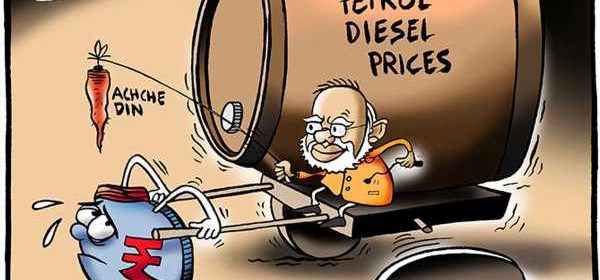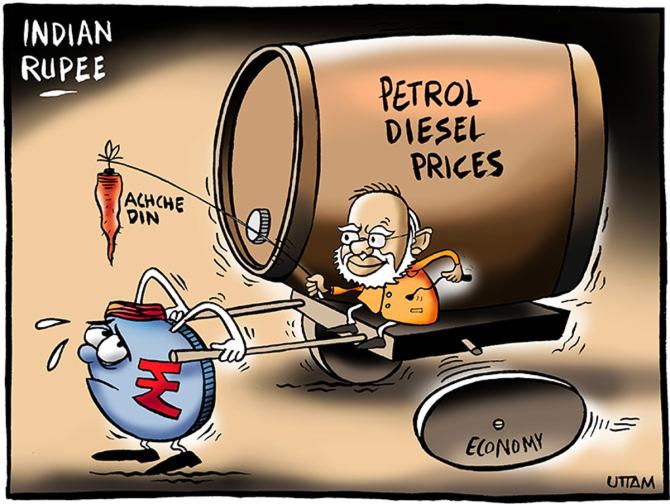India’s fuel pricing mechanism is opaque and removed from reality

The Modi government should find a way out of this conundrum before it loses itself in the maze.
S Dinakar reports.
What could be more uncertain than Virat Kohli’s agonising wait for a century for over two years?
Perhaps it’s what you will pay tomorrow morning to fill your vehicle’s tank.
Pump prices have joined cricket scores as the country’s favourite discussion topic.
Steep increases invite widespread protests, while moderate additions make the government anti-reformist.
The ongoing fuel price conundrum is no different.
State-run refiners, which control over four-fifths of India’s fuel market, are yet again walking a tightrope, trying to balance the interests of consumers, government and their own.
They typically perform this balancing act on two occasions — once, around election time and the second when geopolitics, such as the war in Ukraine, sends crude prices higher.
This time though, IOC, BPCL and HPCL, who claim to adjust fuel rates on the basis of international crude levels and the exchange rate, started performing the fuel jig from early 2020 when Covid-19 hit Indian shores.
Despite a plunge of 64 per cent in the Indian crude basket in April 2020 compared to February 2020, to an average $19.90 a barrel, state oil companies kept a near Rs 70 a litre grip on petrol and Rs 62 a litre on diesel.
Prices of petrol and diesel continued rising in 2020 to Rs 84 a litre and to Rs 74 a litre, while the Indian crude basket hovered for most of the year in the $40 levels.
For instance, when crude was 33 per cent lower in November 2020 compared to January 2020, pump prices rose by as much as 9 per cent during the period.
In another case, the Indian crude basket, a cocktail of sweet and sour crudes, fell by 10 per cent in December 2021 over November but state oil companies refused to pass on the gains to consumers.
When people were struggling for shelter, jobs and daily provisions amid pandemic-induced lockdowns, it may have seemed as though the government and oil firms were profiteering.
In retrospect, perhaps, that wasn’t so bad.
It was that usury-like tactic that helped oil companies cream profits and enabled the government to earn enough to spend on vaccines and rations for the poor, albeit at the expense of consumers.
It also came to the aid of motorists as international oil prices rose to $135 a barrel, but the increase in pump rates was much lower.
Estimates by Moody’s Investors Service peg the revenue losses since November at IOC, BPCL and HPCL at $2.25 billion, some of which may be recouped from the excess gains made by refiners in 2020.
Based on current market prices, oil marketing companies are currently realising $25 a barrel (around Rs 12/litre) lower on petrol and $24 a barrel lower on sale of diesel, Moody’s said.
Retail fuel prices rose by only around Rs 4 a litre last week compared to a Rs 25 a litre in diesel for bulk users.
LPG prices rose by only 5 per cent despite the Indian crude basket, excluding freight and insurance, at $118/barrel on March 24 — 46 per cent higher than November.
Crisil Research expects pump prices to rise by Rs 12 a litre if crude averages $100 a barrel, and by Rs 20 a litre if crude prices average $120 a barrel.
Though the ultimate goal of the government to moderate price increases of petrol and diesel is laudable, it causes immense collateral damage — hurting shareholders, private sector investors, the economy and damaging prospects for India’s refining and fuel marketing businesses.
Reliance Industries failed to conclude a $15 billion stake sale deal with Saudi Aramco; there’s little interest in a $12 billion BPCL stake sale; and there is no clarity on the future of the Ratnagiri refinery with Aramco and UAE’s Adnoc as partners.
The fuel pricing mechanism is opaque and removed from reality, and, if the government feels — with reason — it should intervene when oil prices surge, there should be clear rules and mechanisms to trigger such moves.
That makes the fuel pricing process transparent and easy for the Aramcos, Adnocs and BPs to assess the risks of investing in India’s oil sector, and also for a small entrepreneur in Gujarat to decide if he should start a retail outlet to sell Reliance-branded fuels.
It also helps the hapless motorist to get a handle on how much he or she will end up paying for fuel in a month.
Imagine the plight of an average household that’s clueless on how much and how frequently cooking gas prices will increase — prices were frozen since October 6, despite Saudi Aramco’s LPG price, a benchmark for cooking gas prices, averaging $784 a tonne in October, $841 in November and $769 in February.
During the 137-day lull in pump prices, the India crude basket averaged $82 a barrel in October, $73 in December and $94 in February.
Finally, after polls ended in Uttar Pradesh, there were four increases last week at the pump.
Many more will likely follow.
However, one cannot expect households to compensate refiners for past losses by paying more for fuel today from a shrinking monthly household budget.
Oil companies are deploying pricing tactics such as cross subsidisation of products or making bulk users of diesel pay more to alleviate the burden on the consumer.
Last week, IOC, whose bulk sales account for 25 per cent of total diesel shipments, increased prices of diesel for bulk users by Rs 25 a litre.
In other cases, fuels that made little difference to the BJP’s electoral fortunes in UP or Uttarakhand, such as aviation fuel, saw huge price increases.
State oil companies will also offset some marketing losses with stronger refinery margins, which increased five-fold to as high as $10 a barrel from 2020.
But if crude stays strong and refinery margins retreat, then pump rates must rise sharply or refiners will face cash flow problems.
No government in India is inclined to lift the pedal off fuel prices — allowing businesses to make changes to rates, and stick to the state’s job of preventing cartelisation.
Petrol, diesel and LPG have instead been turned into potent political giveaways during elections.
The Modi government should find a way out of this conundrum before it loses itself in the maze.
Source: Read Full Article

